
The Peruvian Horse is a breed of light saddle horse known for its smooth ride. It is distinguished by a natural, four-beat, lateral gait called the paso llano. This breed is protected by the Peruvian government through Decree number 25919 of Peru enacted on November 28, 1992, and has been declared a Cultural Heritage of the Nation by the National Institute of Culture (INC). Due to the isolation suffered for about 400 years and the selection made by their breeders, this breed is very particular in their body proportions and an ambling gait or "paso llano" that is characteristic. It is typical of the northern Peruvian regions of the country from which it originated. Trujillo city is considered the cradle of typical Peruvian Horses.

The Standardbred is an American horse breed best known for its ability in harness racing, where members of the breed compete at either a trot or pace. Developed in North America, the Standardbred is recognized worldwide, and the breed can trace its bloodlines to 18th-century England. They are solid, well-built horses with good dispositions. In addition to harness racing, the Standardbred is used for a variety of equestrian activities, including horse shows and pleasure riding, particularly in the Midwestern and Eastern United States and in Southern Ontario.

The Paso Fino is a naturally gaited light horse breed dating back to horses imported to the Caribbean from Spain. Pasos are prized for their smooth, natural, four-beat, lateral ambling gait; they are used in many disciplines, but are especially popular for trail riding. In the United States two main groups of horses are popularly called "Paso Fino": One, also known as the Pure Puerto Rican Paso Fino (PPR), originated in Puerto Rico. The other, often called the Colombian Paso Fino or Colombian Criollo Horse (CCC), developed in Colombia. Though from similar Spanish ancestors, the two groups developed independently of one another in their home nations.

Horses can use various gaits during locomotion across solid ground, either naturally or as a result of specialized training by humans.

The Icelandic horse is a breed of horse developed in Iceland. Although the horses are small, at times pony-sized, most registries for the Icelandic refer to it as a horse. Icelandic horses are long-lived and hardy. In their native country they have few diseases; Icelandic law prevents horses from being imported into the country and exported animals are not allowed to return. The Icelandic displays two gaits in addition to the typical walk, trot, and canter/gallop commonly displayed by other breeds. The only breed of horse in Iceland, they are also popular internationally, and sizable populations exist in Europe and North America. The breed is still used for traditional sheepherding work in its native country, as well as for leisure, showing, and racing.

The Mangalarga Marchador is a Brazilian breed of riding horse. It is the national horse breed of Brazil, where there are more than half a million of them; it is among the most numerous breeds of riding horse in the world. It derives from cross-breeding of Portuguese Alter Real horses with local Criollo stock. It displays four gaits: the walk, the canter, and two ambling gaits, the marcha batida and the marcha picada; it does not trot.

The Morgan horse is one of the earliest horse breeds developed in the United States. Tracing back to the foundation sire Figure, later named Justin Morgan after his best-known owner, Morgans served many roles in 19th-century American history, being used as coach horses and for harness racing, as general riding animals, and as cavalry horses during the American Civil War on both sides of the conflict. Morgans have influenced other major American breeds, including the American Quarter Horse, Tennessee Walking Horse and the Standardbred. During the 19th and 20th centuries, they were exported to other countries, including England, where a Morgan stallion influenced the breeding of the Hackney horse. In 1907, the US Department of Agriculture established the US Morgan Horse Farm near Middlebury, Vermont for the purpose of perpetuating and improving the Morgan breed; the farm was later transferred to the University of Vermont.The first breed registry was established in 1909, and since then many organizations in the US, Europe and Oceania have developed. There were estimated to be over 175,000 Morgan horses worldwide in 2005.

The American Saddlebred is a horse breed from the United States. This breed is referred to as the "Horse America Made". Descended from riding-type horses bred at the time of the American Revolution, the American Saddlebred includes the Narragansett Pacer, Canadian Pacer, Morgan and Thoroughbred among its ancestors. Developed into its modern type in Kentucky, it was once known as the "Kentucky Saddler", and used extensively as an officer's mount in the American Civil War. In 1891, a breed registry was formed in the United States. Throughout the 20th century, the breed's popularity continued to grow in the United States, and exports began to South Africa and Great Britain. Since the formation of the US registry, almost 250,000 American Saddlebreds have been registered, and can now be found around the world, with separate breed registries established in Great Britain, Australia, continental Europe, and southern Africa.

The trot is a two-beat diagonal horse gait where the diagonal pairs of legs move forward at the same time with a moment of suspension between each beat. It has a wide variation in possible speeds, but averages about 13 kilometres per hour (8.1 mph). A very slow trot is sometimes referred to as a jog. An extremely fast trot has no special name, but in harness racing, the trot of a Standardbred is faster than the gallop of the average non-racehorse, and has been clocked at over 30 miles per hour (48 km/h).

A palfrey is a type of horse that was highly valued as a riding horse in the Middle Ages. It was a lighter-weight horse, usually a smooth gaited one that could amble, suitable for riding over long distances. Palfreys were not a specific breed as horse breeds are understood today.
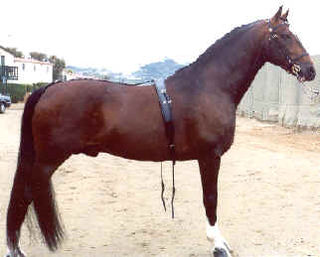
The Hackney is a recognized breed of horse that was developed in Great Britain. In recent decades, the breeding of the Hackney has been directed toward producing horses that are ideal for carriage driving. They are an elegant high stepping breed of carriage horse that is popular for showing in harness events. Hackneys possess good stamina, and are capable of trotting at high speed for extended periods of time.
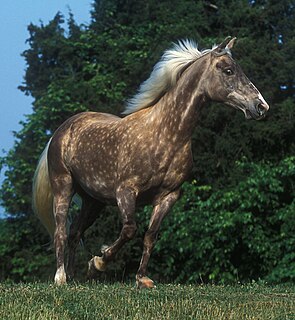
The Rocky Mountain Horse is a horse breed developed in the state of Kentucky in the United States. Despite its name, it originated not in the Rocky Mountains, but instead in the Appalachian Mountains. A foundation stallion, brought from the western United States to eastern Kentucky around 1890, began the Rocky Mountain type in the late 19th century. In the mid-20th century, a stallion named Old Tobe, owned by a prominent breeder, was used to develop the modern type; today most Rocky Mountain Horses trace back to this stallion. In 1986, the Rocky Mountain Horse Association was formed and by 2005 has registered over 12,000 horses. The breed is known for its preferred "chocolate" coat color and flaxen mane and tail, the result of the relatively rare silver dapple gene acting on a black coat, seen in much of the population. It also exhibits a four-beat ambling gait known as the "single-foot". Originally developed as a multi-purpose riding, driving and light draft horse, today it is used mainly for trail riding and working cattle.

An ambling gait or amble is any of several four-beat intermediate horse gaits, all of which are faster than a walk but usually slower than a canter and always slower than a gallop. Horses that amble are sometimes referred to as "gaited", particularly in the United States. Ambling gaits are smoother for a rider than either the two-beat trot or pace and most can be sustained for relatively long periods, making them particularly desirable for trail riding and other tasks where a rider must spend long periods in the saddle. Historically, horses able to amble were highly desired for riding long distances on poor roads. Once roads improved and carriage travel became popular, their use declined in Europe but continued in popularity in the Americas, particularly in areas where plantation agriculture was practiced and the inspection of fields and crops necessitated long daily rides.
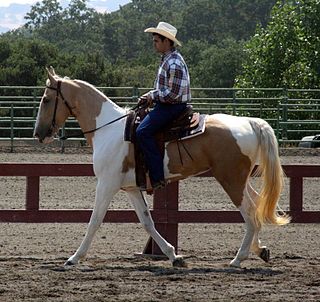
The Spotted Saddle Horse is a horse breed from the United States that was developed by crossing Spanish-American type gaited pinto ponies with gaited horse breeds, such as the Tennessee Walking Horse. The result was a colorful, smooth-gaited horse, used in the show ring and for pleasure and trail riding. Two registries have been created for the breed, one in 1979 and the other in 1985. The two have similar registration requirements, although one has an open stud book and the other is slightly more strict with regard to parentage requirements, having a semi-closed stud book. The Spotted Saddle Horse is a light riding horse, always pinto in color. Solid-colored foals from registered parents may be registered for identification purposes, so their pinto-colored foals have documented parentage. They always perform an ambling gait, rather than a trot, in addition to the gaits of walk and canter, performed by all breeds.
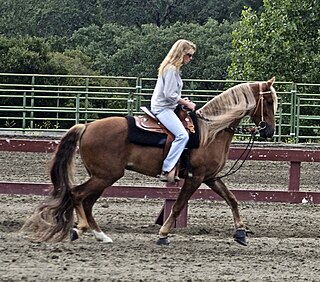
The Kentucky Mountain Saddle Horse is a horse breed from the U.S. state of Kentucky. Developed as an all-around farm and riding horse in eastern Kentucky, it is related to the Tennessee Walking Horse and other gaited breeds. In 1989 the Kentucky Mountain Saddle Horse Association (KMSHA) was formed, and in 2002, the subsidiary Spotted Mountain Horse Association (SMHA) was developed to register Kentucky Mountain Saddle Horses with excessive white markings and pinto patterns. Conformation standards are the same for the two groups of horses, with the main difference being the color requirements. The KMSHA studbook is now closed to horses from unregistered parents, although it cross-registers with several other registries, while the SMHA studbook remains open.

The Carolina Marsh Tacky or Marsh Tacky is a rare breed of horse, native to South Carolina. It is a member of the Colonial Spanish group of horse breeds, which also include the Florida Cracker Horse and the Banker horse of North Carolina. It is a small horse, well adapted for use in the lowland swamps of its native South Carolina. The Marsh Tacky developed from Spanish horses brought to the South Carolina coast by Spanish explorers, settlers and traders as early as the 16th century. The horses were used by the colonists during the American Revolution, and by South Carolinians for farm work, herding cattle and hunting throughout the breed's history.
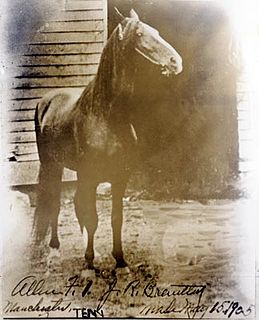
Black Allan or Allan F-1 was the foundation sire of the Tennessee Walking Horse. He was out of a Morgan mare named Maggie Marshall and by Allendorf, a stallion descended from Narragansett Pacer, Canadian Pacer, and Gaited Spanish Mustang imported from Texas. Black Allan was registered as No. 7623 by the American Trotting Registry. Although Black Allan was supposed to be a trotter, he preferred to pace and so never raced. Besides the pace, he performed a lateral ambling gait now known as the running walk. He was a black stallion standing 15 hands, 5 feet high. He was given the designation Allan F-1 when the Tennessee Walking Horse Breeders' Association, precursor to the Tennessee Walking Horse Breeders' and Exhibitors' Association, was formed in 1935. He had multiple owners throughout his life, but his last owners, James Brantley and Albert Dement, were the only ones to recognize Black Allan's use as a breeding stallion. Black Allan sired 111 known foals in his lifetime, among them Roan Allen, registration number F-38, Hunters Allen F-10, and Merry Legs F-4. Black Allan died September 16, 1910, at the age of 29.

The Mountain Pleasure Horse is a breed of gaited horse that was developed in the Appalachian Mountains of Eastern Kentucky. This breed reflects the primitive Appalachian gaited horse type and genetic testing shows them to share ancestry with earlier breeds developed in the region, including the American Saddlebred, the Tennessee Walking Horse and the Rocky Mountain Horse. Some Mountain Pleasure Horse bloodlines are traceable for over 180 years.

Five-gaited horses are notable for their ability to perform five distinct horse gaits instead of simply the three gaits, walk, trot and canter or gallop common to most horses. Individual animals with this ability are often seen in the American Saddlebred horse breed, though the Icelandic horse also has five-gaited individuals, though with a different set of gaits than the Saddlebred.




















